Cruise Itinerary
| Date | Activity | Arrive | Depart |
|---|---|---|---|
| 28 Apr 2024 | Aberdeen, Scotland |
Hotel | |
| 29 Apr 2024 | Aberdeen, Scotland |
Embark | |
| 30 Apr 2024 | Fair Isle Shetland Islands |
||
| 01 May 2024 | Faroe Islands, Denmark |
||
| 02 May 2024 | Faroe Islands, Denmark |
||
| 03 May 2024 | At sea | ||
| 04 May 2024 | At sea | ||
| 05 May 2024 | Jan Mayen Island Norway |
||
| 06 May 2024 | Jan Mayen Island Norway |
||
| 07 May 2024 | At sea | ||
| 08 May 2024 | Spitsbergen, Norway |
||
| 09 May 2024 | Spitsbergen, Norway |
||
| 10 May 2024 | Spitsbergen, Norway |
||
| 11 May 2024 | Longyearbyen, Spitsbergen |
Disembark | Flight to Helsinki |
| 11 May 2024 | Helsinki, Finland |
All itineraries and ports of call at the discretion of the cruise line subject to local weather conditions and may change without notice.
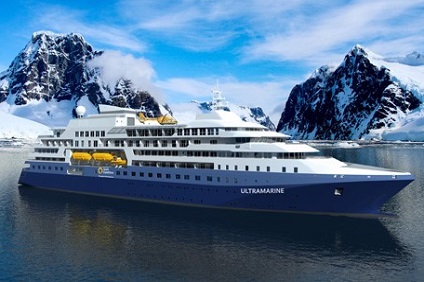
12 Night Cruise sailing from Aberdeen to Longyearbyen aboard Ocean Adventurer. Hotel stay pre-cruise in Aberdeen.
Please note: The itinerary shown includes land/flight components that are part of a Mandatory Transfer Package which may be at an additional cost. Please check at time of enquiry/booking.
Day 1 Arrive in Aberdeen, United Kingdom
Arrive any time on Day 1 and make your way to your included hotel. The gateway for your Arctic adventure, the Scottish city of Aberdeen has many monikers, but its most famous is Granite City, as it was once the granite capital of the world. Wandering the streets, you’ll soon see why, as the Victorian buildings sparkle in the sun. A bustling cultural hub, Aberdeen also offers a range of museums, galleries, theaters, shops, cafés and restaurants to explore.
Day 2 Embarkation Day
Today you will have some free time before being transferred to the port to board your ship. As you set sail this afternoon, you’ll want to be out on deck, camera in hand—the area’s coastal waters offer excellent possibilities for spotting bottlenose and white-beaked dolphins, harbor porpoises and minke whales.
Day 3 Exploring Fair Isle
The U.K.’s most remote inhabited island, the extraordinary Fair Isle is located halfway between the Shetland and Orkney Islands. Boasting a rugged beauty, Fair Isle’s landscape is diverse, with fields and moors dominated by seaside cliffs and an astounding number of sea stacks, natural arches and caves. Despite its small size, the island offers activities for history, nature and photography buffs alike. Visit the museum to immerse yourself in local artifacts, photos, knitwear and other historic memorabilia. Don’t forget to snap a shot of the circa 1935 classic
red phone booth by the post office!
In terms of wildlife, orcas are native to the waters around Fair Isle, and they sometimes come close in pursuit of seals. But the island is best known for its coastal cliffs teeming with seabirds in spring and summer. The star attraction is the Atlantic puffin, a clown-like bird that burrows in nests in the grassy flat tops of the island’s cliffs. Photographers will surely want to capture pictures of their bemused expressions, and Fair Isle’s easily accessible grassy banks make it one of the best places in the Shetlands (if not the entire Scottish Isles!) to observe these colorful creatures. Northern fulmars, kittiwakes, storm petrels, razorbills and guillemots may be spotted soaring over the open waters.
Visitors to this community of crofters, artisans and artists may be able to pick up a traditional Fair Isle sweater to keep warm during the rest of your Arctic voyage.
Days 4 and 5 Exploring the Faroe Islands
Known for its beautiful, unspoiled landscape, with verdant pastures giving way to rugged, steep cliffs, the Faroe
Islands have a storied past, though the details of the archipelago’s early history remain mysterious. The first settlers may have been seventh-century Irish monks seeking solitude on these islands far removed from any continent. Their isolation ended in 800 AD, with the arrival of Norse farmers, and Norwegian colonization continued throughout the Viking Age. Today, many of the inhabitants of the Faroe Islands, now a self-governing country within the Kingdom of Denmark, are descendants of Norwegian Vikings, and speak Faroese, a descendant language of Old Norse.
We will have two days to explore this seldom-visited archipelago made up of 18 rugged islands located about halfwaybetween Scotland and Iceland. The mighty North Atlantic is omnipresent wherever we go with no place on the Faroe Islands farther than 3 miles (5 km) from its shores. The sea has always dominated life on the Faroes—throughout history as much as today: rich fisheries, magnificent ocean views and thriving sea bird colonies make up this rare Nordic jewel— often referred to as Europe’s best kept secret.
We will spend a day exploring the outer islands of the archipelago, separated by narrow sounds and fjords, and delight in their surreal landscapes, dramatic cliffs, and rock formations. You’ll see green valleys engulfed by steep mountains, protecting picturesque villages with colorful turf-topped homes. Wind, weather and sea conditions will influence and shape our activity options, but we will of course always keep our eyes out for marine and bird life, especially the iconic Atlantic puffin.
Our second day in the Faroes will be dedicated to the capital city of Tórshavn, where the Vikings established their government in 825 AD. One of the world’s smallest capitals, the picturesque Tórshavn has a relaxed vibe and a number of historical and cultural sites. Meander the maze of narrow laneways of the Old Town, admiring the quaint wooden houses with traditional sod roofs and white paned windows. If you’re looking for more action, a hike to historic Kirkjubøur not only unlocks some of the country’s best medieval history but also rewards with sweeping views over the southern islands of Koltur, Hestur & Sandur. Or perhaps you’ll prefer to wander the charming harbor, filled with cafés, pubs and old warehouses, and simply gaze out at the sea while sipping a latte.
Days 6 and 7 Cruising
Say goodbye to the Faroes as we cruise toward the world’s most northerly volcanic island, Jan Mayen. There are several activities to keep you engaged while at sea. Learn to identify seabirds gliding alongside your ship, attend dynamic presentations by your Expedition Team, relax in our polar library or simply spend some time on deck, admiring the ocean views. With your binoculars and camera at the ready, keep your eyes peeled for the blow of a humpback, blue or fin whale. Encounters with minke whales or orcas are also possible, since their curiosity can bring them near the ship. If you’re lucky, you may even see harp seals.
Days 8 and 9 Exploring Jan Mayen
North of the Arctic Circle, about 280 miles (450 km) east of Greenland and 340 miles (550 km) north of Iceland, the mysterious Jan Mayen rises from the depths of the North Atlantic Ocean. Often shrouded in thick fog, the small mountainous island was declared a nature reserve in 2010 and is rarely visited, save for the 18 rotating personnel of the Norwegian military and Norwegian Meteorological Institute, who are the only year-long inhabitants, save for some additional personnel during the summer.
Landing here will be dictated by the weather and sea. If conditions allow, as we approach, keep watch on deck as the spoon-shaped island’s highest summit emerges. At 7,470 feet (2,277 meters) high, the breathtaking Beerenberg volcano features a symmetrical cone shape and impressive glaciers that spill into the sea. During the summer months, the island’s lower landscape is covered with grass, moss and a smattering of hardy flowers that add a burst of color to the otherwise barren black lava terrain. One site we hope to visit is Olonkinbyen and the surrounding area. Named after Russian-Norwegian polar explorer Gennady Olonkin, it’s the island’s only settlement and the location of the meteorological station, where you may have the chance to learn about polar research while seeing how weather is monitored at the top of the world.
Another option might be the black sand beach at Kvalrossbukta, where the remnants of a 17th-century Dutch whaling station and a large northern fulmar colony can be found. In 1632, two Basque ships landed at the small bay and plundered the station. A Dutch party was sent here the following year to protect the land stations during winter, but all seven men perished from scurvy. Whaling in the area came to an end about 20 years later.
If conditions permit, we may view the volcano and the stratified cliffs of the spectacular north coast as we Zodiac cruise around the island, searching for wildlife. Designated an Important Bird Area by BirdLife International for the large numbers of breeding seabirds, Jan Mayen supports colonies of northern fulmars, little auks, glaucous gulls, kittiwakes, and black and Brünnich’s guillemots (thick-billed murres). And if we are fortunate, you might see “sea parrots,” the Atlantic puffin again. The waters here are rich feeding grounds for marine life, so keep a lookout for minke, fin, blue or humpback whales.
Day 10 At Sea
As we sail farther north, spend some time with your shipmates in the lounge, swapping stories and photos, or pause for a moment on the bridge, joining in as your Expedition Team looks out for whales, seals and a variety of seabirds.
Days 11 to 13 Exploring Spitsbergen, Svalbard
Rugged, wild and situated entirely within the Arctic Circle, the largest island of the Svalbard archipelago is unforgettable. From immense glaciers to lush tundra to polar deserts, the landscape here is as varied as the wildlife.
As we explore the fjords of the southwestern corner of this magical island, it won’t take long for you to see firsthand why Spitsbergen is the “wildlife capital of the Arctic.” Some areas we hope to visit include Hornsund and Bellsund fjords and Hornbreen Glacier.
The possible landing sites at Hornsund, the island’s most southerly fjord, have rich histories. You may visit Isbjornhamna, a bay at the entrance of the fjord, where we hope to explore colonies of delightful little auks. You may also spot Svalbard reindeer and hike to a viewpoint for views of calving glaciers. A 12-mile (20 km) long sound, Bellsund lured miners a century ago to its natural resources. Today, visitors come to Bourbonhamna and Calypsobyen to see historic mining and trapper sites and marvel at the magnificent vistas. It may also be possible to hike along the colorful tundra, dotted with flowers bursting for a taste of sunshine, and discover old whale bones.
Day 14 Disembark in Longyearbyen and Fly to Helsinki
The time has come to say farewell to your newfound friends and Expedition Team. After disembarking, spend the day exploring the frontier-style settlement of Longyearbyen before catching the charter flight to Helsinki.

This ship, whose name means “beyond the sea”, will redefine what is possible in the Polar Regions. This ship will be more than just a ship—it will be an unrivalled home base that allows our guests to experience the Polar Regions in ways never before seen.
Two helicopters and two operable helidecks will allow more of our passengers to simultaneously experience new destinations accessible only by air, and enjoy a once in a lifetime aerial perspective of the Polar Regions.
Ultramarine offers the largest selection of adventure options, including sea kayaking, paddling, camping, mountaineering, skiing, and standup paddle boarding. And now, for the first time ever, the opportunity for flightseeing, helihiking, and heliskiing.
Nature doesn’t wait. Ultramarine’s water-level Zodiac hangar houses 20 Zodiacs launched from four embarkation points easily accessible from two ready rooms. When wildlife has been spotted or a magical sunset appears, passengers won’t miss a thing.
Optimized fuel, water, provisioning, and waste-handling systems have enabled a best-in-class, 70-day operational range that will allow Ultramarine to offer up a completely new set of polar experiences to your clients—from the design of unprecedented new itineraries to exploring new, never-before-seen landing sites.
Ship Profile & Stats
- Length: 128 metres
- Passenger Capacity (dbl): 199
- Ship Registration: Marshall Islands
Ship Amenities
- In Room Safe
- Heated Bathroom Floors
- Individual Climate Control
- HD Flatscreen Television
- Electric Current 220V
- Refrigerator
Ship Facilities
- Bistro Dining Room
- Fitness Centre
- Spa & Sauna
- Library
- Panorama Lounge & Bar
- Lecture Theatre
- Main Restaurant
- 2 Ready Rooms with Individual Lockers
- Polar Boutique
- Medical Centre
- Lift
- 4 Bars

Quark Expeditions has been one of the leading innovators and operators of expedition cruises, especially in polar regions, since 1991. The company has pioneered and developed a concept of fantastically adventurous journeys in first class comfort on powerful, polar icebreakers. This concept is unique and many “First Ever” passenger voyages have been successfully operated: the first North Pole voyage, the first transpolar voyage through the North Pole, the first Circumnavigation of Antarctica, the first “Far Side” of Antarctica voyage, the first Weddell Sea voyage, the first Northeast Passage and the first Circumnavigation of the Arctic are all part of this tradition.
Names such as Amundsen, Scott, Shackleton, Franklin, Peary and Nansen are synonymous with the Golden Age of Exploration and, thanks to the polar climates, elements of the past have been well preserved. Viewing these historical sights is a great experience and worthy of care and respect. Quark Expeditions understands this and ensures that all our passengers are fully briefed before any visits take place.
Select the Deck to view detail.
Select the Cabin to view detail.
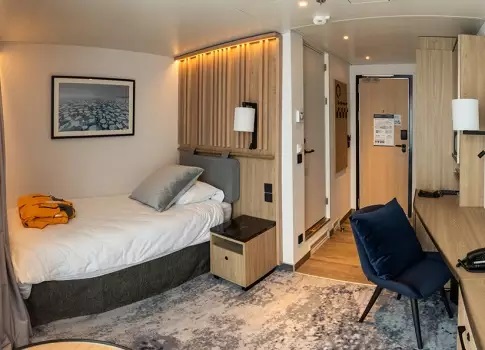

Located on Deck 6, and approximately 132 sq. ft. (12.3 m2). This suite is perfect for solo guests who appreciate privacy and want to wake up to sweeping views from the comfort of their bed. These are the only solo suites with floor-to-ceiling windows available onboard any ship in its class.
Features: single bed, floor-to-ceiling window, desk, refrigerator, TV, private bathroom with shower and heated floors.
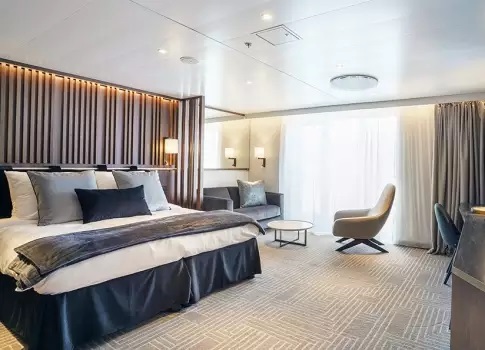

Located on Decks 4 and 6, with approximately 299 sq. ft. (27.8 m2) of indoor living space, and a 70 sq. ft. (6.5 m2) balcony. This suite is perfect for guests wanting a larger living space, full bathroom, and a substantial balcony. Deluxe Balcony Suites are the first suite type to offer additional privacy in the bathroom with an enclosed toilet, a full bath and shower to make it easier for guests to get ready together in the morning.
Features: one double or two single beds, sitting area with sofa bed, private balcony, desk, refrigerator, TV, private bathroom with shower, bathtub and heated floors.
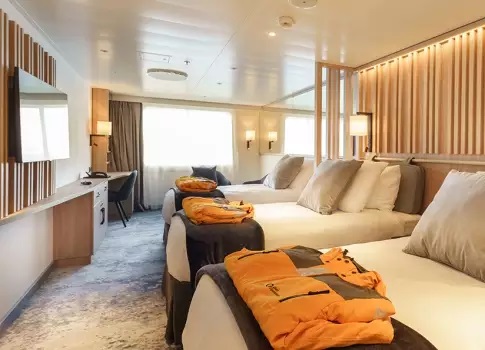

Located on Deck 3, and approximately 285 sq. ft. (26.5 m2). This suite is perfect for guests traveling solo who want to share their experience with other like-minded travelers of the same gender, or for groups of three traveling together. Featuring three separate single beds, and amenities for each of the three guests.
Features: three single beds (two of which can be combined into a double bed), sitting area, picture window, desk, refrigerator, TV, private bathroom with shower and heated floors.
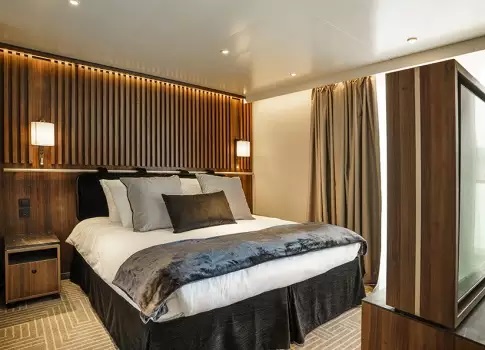

Located on Deck 6, with approximately 350 sq. ft. (32.5 m2) of indoor living space, and a 100 sq. ft. (9.3 m2) balcony. This suite is perfect for guests wanting generous interiors with a wide layout and the largest balconies on the ship. Centrally located on Deck 6, guests will enjoy minimal movement and motion from the comfort of these suites.
Features: one double or two single beds, sitting area with sofa bed, private extra-wide balcony, desk, refrigerator, TV, private bathroom with shower, bathtub and heated floors.
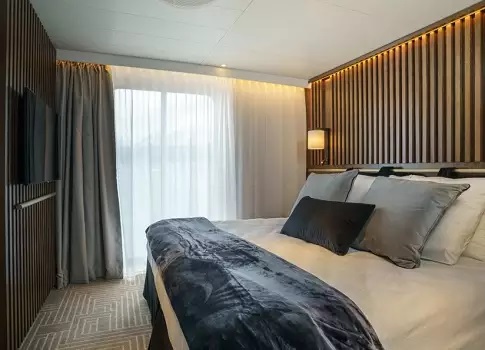
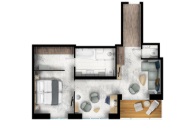
Located on Deck 6, with approximately 446 sq. ft. (41.4 m2) of indoor living space and a 46.3 sq. ft. (4.3 m2) balcony. This suite is perfect for guests who want it all. A large, luxurious suite featuring a private bedroom, full bathroom, powder room, and two separate living spaces. This suite is perfect for families or couples who want all the comforts of home onboard the ship.
Features: one double or two single beds in a private bedroom with walk-in closet, sitting area with sofa bed and additional closet, private balcony, desk, refrigerator, TV, private bathroom with shower, bathtub and heated floors and separate powder room.
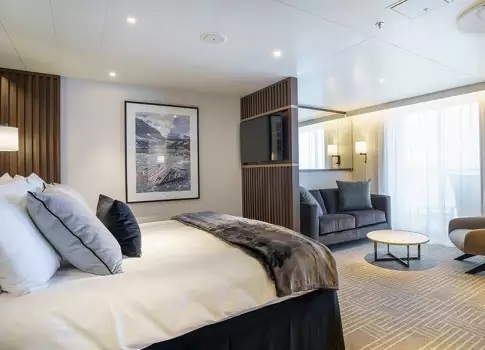

The only suite category to be located on Deck 7, with approximately 369 sq. ft. (34.3 m2) of indoor living space, and a 67 sq. ft. (6.2 m2) balcony. This suite is perfect for guests wanting to wake up to unobstructed polar views from the warmth and comfort of their bed onboard the ship. These suites offer the best of everything—views, spacious interiors, full bathrooms and generous balcony sizes—as well as easy access to the wellness centre.
Features: one double or two single beds, sitting area with sofa bed, private balcony, desk, refrigerator, TV, private bathroom with shower, bathtub and heated floors.
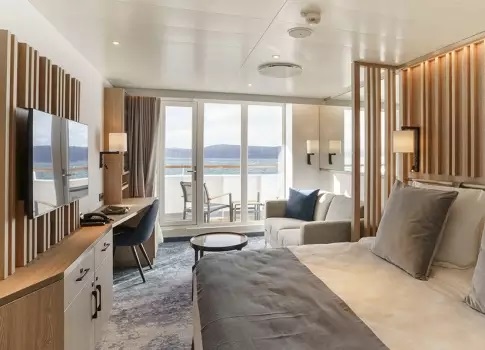

Located on Decks 4 and 6, with approximately 226 sq. ft. (21 m2) of indoor living space, and a 52 sq. ft. (4.8 m2) balcony, this entry-level balcony suite is one of the largest available on a ship of this class. This suite is perfect for guests who are looking for both indoor and outdoor living spaces. There are four connecting suites in this category, making this an excellent option for families or groups wanting to stay connected to each other during their expedition.
Features: one double or two single beds, sitting area with sofa bed, private balcony, desk, refrigerator, TV, private bathroom with shower and heated floors.
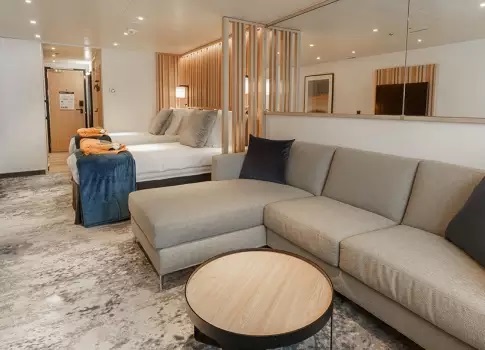

Located on Deck 3, and approximately 285 sq. ft. (26.5 m2). These suites are perfect for people traveling together or solo guests looking to share with like-minded individuals. This suite maximizes interior living space while still offering guests the opportunity to stay connected to the outdoors. Our entry-level twin suites are the largest available on a ship of this class.
Features: one double or two single beds, sitting area with sofa bed, picture window, desk, refrigerator, TV, private bathroom with shower and heated floors.
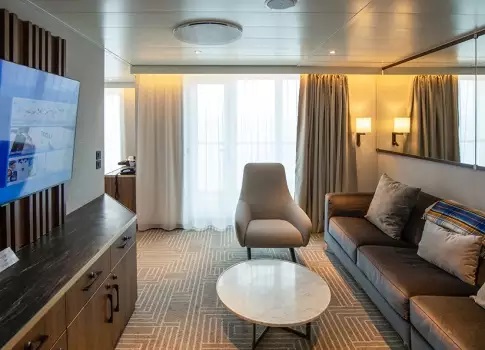

Located on Deck 6, with approximately 563 sq. ft. (52.3m2) of interior living space, and a 46 sq. ft. (4.3 m2) balcony. This suite is perfect for guests who want to travel without compromise. Our largest and most luxurious suite features the most sleeping, entertainment and storage space onboard the ship. It is perfect for families or travelers who want all the comforts of home onboard the ship.
Features: one double or two single beds in a private bedroom with walk-in closet, sitting area with sofa bed and additional walk-in hallway closet, private balcony, desk, refrigerator, TV, private bathroom with shower, bathtub and heated floors and separate powder room.

Located on Deck 3, and approximately 285 sq. ft. (26.5 m2). This suite is perfect for guests traveling solo who want to share their experience with other like-minded travelers of the same gender, or for groups of three traveling together. Featuring three separate single beds, and amenities for each of the three guests.
Features: three single beds (two of which can be combined into a double bed), sitting area, picture window, desk, refrigerator, TV, private bathroom with shower and heated floors.

Located on Deck 6, with approximately 350 sq. ft. (32.5 m2) of indoor living space, and a 100 sq. ft. (9.3 m2) balcony. This suite is perfect for guests wanting generous interiors with a wide layout and the largest balconies on the ship. Centrally located on Deck 6, guests will enjoy minimal movement and motion from the comfort of these suites.
Features: one double or two single beds, sitting area with sofa bed, private extra-wide balcony, desk, refrigerator, TV, private bathroom with shower, bathtub and heated floors.
* Unless otherwise noted all pricing is on a per person twin share basis. All prices based on cash payment - credit card fees may apply. Cruise deposit, amendment and cancellation conditions apply. Special conditions may apply - please ask for full details at time of enquiry. All passports, vaccinations and visas are the responsibility of the travelling guest to secure prior to departure from Australia. Any pricing not in Australian Dollars will be converted on the day of payment into the relevant currency based on our daily rate of exchange. Please note that many of the prices shown on this website are not shown in real time. Whilst we endeavour to keep our pricing as up-to-date as possible, the advertised prices shown here may differ slightly from the live prices in our booking system. All pricing and offers are subject to availability at time of booking. Whilst all information is correct at the time of publication, offers are subject to change. We reserve the right to correct errors without penalty. Please submit any data errors/omissions you may notice on this site.
Unless otherwise expressly noted, all materials, including images, illustrations, designs, icons, and photographs appearing anywhere on this website are protected by worldwide copyright laws and treaty provisions. The copyright on such materials is held by the original creator of the materials. None of the materials may be copied, reproduced, displayed, modified, published, uploaded, posted, transmitted or distributed in whole or in part in any form or by any means other than as provided by Cruise Factory and Cruise Traveller to its clients, or with the prior written permission of Cruise Factory and Cruise Traveller. All rights not expressly granted in these Terms are reserved. Any unauthorised use of the materials appearing on this website may violate copyright, trademark and other applicable laws and could result in criminal or civil penalties.








